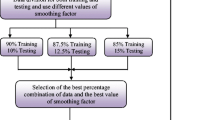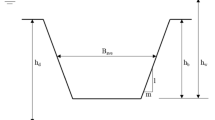Abstract
The study of dam-break analysis is considered important to predict the peak discharge during dam failure. This is essential to assess economic, social and environmental impacts downstream and to prepare the emergency response plan. Dam breach parameters such as breach width, breach height and breach formation time are the key variables to estimate the peak discharge during dam break. This study presents the evaluation of existing methods for estimation of dam breach parameters. Since all of these methods adopt regression analysis, uncertainty analysis of these methods becomes necessary to assess their performance. Uncertainty was performed using the data of more than 140 case studies of past recorded failures of dams, collected from different sources in the literature. The accuracy of the existing methods was tested, and the values of mean absolute relative error were found to be ranging from 0.39 to 1.05 for dam breach width estimation and from 0.6 to 0.8 for dam failure time estimation. In this study, artificial neural network (ANN) was recommended as an alternate method for estimation of dam breach parameters. The ANN method is proposed due to its accurate prediction when it was applied to similar other cases in water resources.














Similar content being viewed by others
References
Atallah TA (2002) A Review on dams and breach parameters estimation. Dissertation, Virginia Polytechnic Institute and State University, Blacksburg
Azmatullah Md H, Deo MC, Deolalikar PB (2005) Neural networks for estimation of scour downstream of a ski-jump bucket. J Hydraul Eng 131(10):898–908
Biswas AK, Chatterjee S (1971) Dam disasters an assessment. Eng J (Canada) 54(3):3–8
Chakravarti A, Joshi N and Panjiar H (2015) Rainfall runoff analysis using artificial neural network. Indian J Sci Technol. doi:10.17485/ijst/2015/v8i14/54370
Chau KW (2006) Particle swarm optimization training algorithm for ANNs in stage prediction of Shing Mun River. J Hydrol 329(3–4):363–367
Chitsazan M, Rahmani G, Neyamadpour A (2013) Groundwater level simulation using artificial neural network: a case study from Aghili plain, urban area of Gotvand, south-west Iran. J Geope 3(1):35–46
Cigizoglu HK, Alp M (2006) Generalized regression neural network in modelling river sediment yield. Adv Eng Softw 37(2006):63–68
Costa JE (1985) Floods from dam failures. Open file report. 85–560, Secretary. p 59
Daliakopoulos IN, Coulibalya P, Tsanis IK (2005) Groundwater level forecasting using artificial neural networks. J Hydrol 309(1–4):229–240. doi:10.1016/j.jhydrol.2004.12.001
DHI Water & Environment (2009) Dam and reservoirs—dam and levee failure modeling and mapping. MIKE Documentation. DHI Group, California
Djurovic N, Domazet M, Stricevic R, Pocuca V, Spalevic V, Pivic R, Gregoric E, Domazet U (2015) Comparison of groundwater level models based on artificial neural networks and ANFIS. Sci World J. doi:10.1155/2015/742138
Dressler RF (1954) Comparison of theories and experiments for the hydraulic dam-break wave. Int As Sci Hydrol 3(38):319–328
Elmazoghi HG (2013) Fuzzy algorithm for estimating average breach widths of embankment dams. Nat Hazards 68:229–248. doi:10.1007/s11069-012-0350-y
Elsafi SH (2014) Artificial neural networks (ANNs) for flood forecasting at Dongola Station in the River Nile, Sudan. Alex Eng J 53:655–662
El-Shafie A, Mukhlisin M, Najah A, Taha MR (2011) Performance of artificial neural network and regression techniques for rainfall–runoff prediction. Int J Phys Sci 6(8):1997–2003
Froehlich D (1995a) Peak outflow from breached embankment dam. J Water Resour Plan Manage 121(1):90–97
Froehlich D (1995b) Embankment dam breach parameters revisited. Water resources engineering. In: Proceedings of the 1995 conference on water resources engineering. Accessed 14–18 Aug, San Antonio, Texas. 887–891
Froehlich D (2008) Embankment dam breach parameters and their uncertainties. J Hydraul Eng 134(12):1708–1721
Gee D (2009) Comparison of dam breach parameter estimators. World Environ Water Resour Congr. doi:10.1061/41036(342)339
Gibbsa MS, Morganb N, Maiera HR, Dandya GC, Nixonc JB, Holmes M (2006) Investigation into the relationship between chlorine decay and water distribution parameters using data driven methods. Math Comput Model 44:485–498. doi:10.1016/j.mcm.2006.01.007
Gruner E (1963) Dam disasters: Proceedings, Institution of Civil Engineers. London, 24:47–60
Hanson G, Cook K, Hunt S (2005) Physical modeling of overtopping erosion and breach formation of cohesive embankments. Trans ASABE 48(5):1783–1794
Haykin S (1994) Neural Networks: a comprehensive foundation, 2nd edn. Prentice-Hall, Upper Saddle River
Hecht-Nielsen R (1987) Kolmogorov’s mapping neural network existence theorem. In: Proc. 1st IEEE Int Conf on Neural Networks. San Diego. 3:11–14
Heddam S (2016) Secchi disk depth estimation from water quality parameters: artificial neural network versus multiple linear regression models. Environ Process. doi:10.1007/s40710-016-0144-4
Hooshyaripor F, Tahershamsi A, Golian S (2014) Application of copula method and neural networks for predicting peak outflow from breached embankments. J Hydro Environ Res 8(3):292–303
Jansen RB (1980) Dams and public safety. U.S. Department of the Interior, Bureau of Reclamation, Denver, p 332
Johnson FA, Illes (1976) A classification of dams failures. In: International water power and dam construction, December 1976, pp 43–45
Joorabchi An, Zhang, H, Blumenstein M (2009) Application of neural network for ground water dynamics in coastal aquifers. Journal of Coastal Research. In: Proceeding of the 10th International Coastal Symposium. 966–970
Kalin L, Sabahattin I, Schoonover JE, Lockaby BG (2010) Predicting water quality in unmonitored watersheds using artificial neural networks. J Environ Qual 39:1429–1440
Khalil BM, Awadallahn G, Karaman H, El-Sayed A (2012) Application of artificial neural networks for the prediction of water quality variables in the nile delta. J Water Resour Prot 4:388–394
Lekkas DF, Cn ONOF, LEE M, BALTAS E (2004) Application of artificial neural networks for flood forecasting. Global Nest. Int J 6(3):204–210
McCulloch WS, Pitts W (1943) A logical calculus of the ideas imminent in nervous activity. Bull Math Biophys 5:115–133
Melesse AM, Ahmad S, McClain ME, Wang X, Lim YH (2011) Suspended sediment load prediction of river systems: an artificial neural network approach. Agric Water Manag 98:855–866
Noori R, Sabahi MS, Karbassi AR (2010) Evaluation of PCA and Gamma test techniques on ANN operation for weekly solid waste predicting. J Environ Manage 91(3):767–771
Palani S, Liong S, Tkalichn P (2008) An ANN application for water quality forecasting. Mar Pollut Bull 56(2008):1586–1597
Pektas AO, Erdik T (2014) Peak discharge prediction due to embankment dam break by using sensitivity analysis based ANN. KSCE J Civil Eng 18(6):1868–1876
Pierce MW, Thornton CI, Abt SR (2010) Predicting peak outflow from breached embankment dams. J Hydrol Eng 15(5):338–349
Powledge GR, Ralston DC, Miller P, Chen YH, Clopper PE, Temple DM (1989a) Mechanics of overflow erosion on embankments. I: research activities. J Hydraul Eng 115(8):1040–1055
Powledge GR, Ralston DC, Miller P, Chen YH, Clopper PE, Temple DM (1989b) Mechanics of overflow erosion on embankments. II: hydraulic and design considerations. J Hydraul Eng 115(8):1056–1075
Rajurkar MP, Kothyari UC, Chaube UA (2002) Artificial neural networks for daily rainfall–runoff modelling. Hydrologkal Sciences-Jo umai-des Sciences Hydrologiques 47:65–877
Ralston DC (1987) Mechanics of embankment erosion during overflow. In: Proc. ASCE National Conference on Hydraulic Engineering, Reston, Va. 733–738
Ramirez MCV, Ferreira NJ, Velho HF (2005) Artificial neural network technique for rainfall forecasting applied to the Sao Paulo region. J Hydrol 301(1–4):146–162
Razad AZA, Muda RS, Sidek LM, Azia ISA, Mansor FH, Yalit R (2013) Simulation of breach outflow for earthfill dam. IOP Conf Ser Earth Environ. Sci 16:12–30
Re R (1946) A study of sudden water releases from a body of water to a canal by the graphical method. La Houille Blanche 1(3):181–187
Riad S, Mania J (2004) Rain–runoff model using an artificial neural network. Math Comput Model 40:839–846
Ritter A (1892) The propagation of water waves. Ver, Deutsch Ingenie (Ver. 8)
Rogers LL, Dowla FU, Johnson VM (1995) Optimal field-scale groundwater remediation using neural networks and the genetic algorithm. Environ Sci Technol 29(5):1145–1155
Rosenblatt F (1958) The perceptron: a probabilistic model for information storage and organization in the brain. Psychol Rev 65(6):386–408
Sakkas JG, Strelkoff T (1973) Dam-break flood in a prismatic dry. J Hydraul Div 99(12):2195–2216
Schocklitch A (1917) On waves created by dam breaches. Adak. Wiss. Proc. 126. Vienna. 1489–1514
Singh KP, Snorrason A (1982) Sensitivity of outflow peaks and flood stages to the selection of dam breach parameters and simulation models. In: SWS Contract Report 288. State Water Survey Division. Department of Energy and Natural Resources, Illinois
State of Colorado Department of Natural Resources Division of Water Resources (2010) Guidelines for dam breach analysis, Rep
Stoker JM (1957) Water waves the mathematical theory with applications. Interscience, New York, pp 452–255
Su ST, Barnes AH (1970) Geometric and frictional effects of sudden releases. J Hydraul Div 96(11):2185–2200
Unal B, Mamak M, Seckin G, Cobaner M (2010) Comparison of an ANN approach with 1-D and 2-D methods for estimating discharge capacity of straight compound channels Adv. Eng Softw 41:120–129
United States Bureau of Reclamation (1988) Downstream Hazard Classification Guidelines, ACER Technical Memorandum No. 11, U.S. Department of the Interior, Bureau of Reclamation, Denver, Colorado
Von Thun JL, Gillette AM (1990) Guidance on breach parameters. Unpublished internal document, U.S. Bureau of Reclamation. Accessed March 13, Denver, Colorado
Wahl TL (1998) Prediction of embankment dam breach parameters: a literature review and needs assessment, dam safety research report DSO-98-004. U.S. Dept. of the Interior, Bureau of Reclamation, Denver
Wahl TL (2004) Uncertainty of predictions of embankment dam breach parameters. J Hydraul Eng 130(5):389–397
Wahl TL (2010) Dam breach modeling—an overview of analysis methods. In: Joint federal interagency conference on sedimentation and hydrologic modeling, 27 June–1July, Las Vegas, NV
Xu Y, Zhang LM (2009) Breaching parameters for earth and rockfill dams. J Geotech Geoenviron Eng 135(12):1957–1970
Zagonjolli M (2007) Dam break modelling, risk assessment and uncertainty analysis for flood mitigation, Dissertation, Delft University of Technology
Acknowledgement
The authors would like to acknowledge the financial support of University Putra Malaysia (Grant type GP-IPS).
Author information
Authors and Affiliations
Corresponding author
Rights and permissions
About this article
Cite this article
Sammen, S.S., Mohamed, T.A., Ghazali, A.H. et al. An evaluation of existent methods for estimation of embankment dam breach parameters. Nat Hazards 87, 545–566 (2017). https://doi.org/10.1007/s11069-017-2764-z
Received:
Accepted:
Published:
Issue Date:
DOI: https://doi.org/10.1007/s11069-017-2764-z




